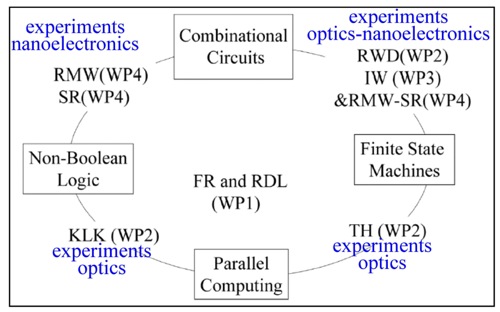MOLOC pursues three routes in parallel, i.e. optical, electrical and chemical addressing, for providing inputs to molecular quantum systems and taking advantage of their internal degrees of freedom. In order to reach the objectives and remain focused, the research efforts of the eight MOLOC participants are organized into four interconnected S/T work packages:- • WP1 is a theoretical WP whose functions are to collaborate with the experimental participants in the design of novel logic schemes, the characterization of new properties emerging in the experimentally implemented structures, the investigation of dynamics upon optical and electrical addressing, and the theoretical investigation of non Boolean logic for optical and electrical addressing and parallel computing. WP1 gathers two participants: Prof. R. D. Levine (HUJI, work-package leader) and Prof. F. Remacle (ULg) • WP2 is devoted to optical addressing of molecular and atomic structures as dopants in solid state, in surface layers and in solution. The WP is essentially defined by the application of (coherent and incoherent) optical interactions between several laser pulses and matter, e.g. implementing resonant multi-photon excitations. The WP gathers four principal investigators (PIs) from three participants : Prof. T. Halfmann (TUKL, work package leader) and Prof. K. Bergmann (TUKL), Prof. R. Weinkauf (UDUS) and Prof. K. L. Kompa (MPQ) • WP3 is devoted to the synthesis of functionalized nanostructures on surfaces. The electronic functions of the nanostructures will then be triggered by electrical, electrochemical, optical or chemical inputs. This is lead by Prof. Itamar Willner(HUJI). • WP4 is devoted to the electrical addressing of molecular systems in a solid, dry state configuration. The addressed systems will range from artificial dopant molecules to hybrid nanoparticle-molecule systems deposited in various nanoelectrode configurations. WP4 gathers three PIs from two participants: Prof. Sven Rogge (TU-Delft, WP leader) and Prof. Rainer M. Waser and Dr. Silvia Karthäuser (FZ-Jülich).
WP5 is devoted to management and assessment of progress and results. The workpackage leader is the coordinator, Prof. F. Remacle (ULg). WP6 deals with dissemination and IPR protection. It is lead by Prof. R. M. Waser (FZ-Jülich). The four S/T workpackages are strongly interconnected as can be seen from the common tasks, deliverables and milestones listed in the work packages descriptions (Tables 1.3c) below. More details about the work planned can be found in the Supplements related to each WP’s at the end of section 1.3.
• The design and implementation of complex molecular logic schemes at the laboratory level requires a close interaction between WP1 and the experimental WP2, WP3 and WP4.
• WP1 will provide support towards a physical understanding of the dynamics charge and energy transfer, and of the conformational changes initiated by optical and/or electrical inputs. The latter are the basis for processing the information at the molecular scale and realizing complex operations. The teams in WP1 exhibit a broad theoretical experience in implementing logic by coherent and multi-photon excitation schemes, which is a solid basis for cooperation with WP2. Moreover, the teams in WP1 have also explored electrical properties of quantum dots arrays which provides its close links to WP3 and WP4
• WP3 will provide hybrid-nanostructures, which will also be electrically addressed in the nanostructure configurations realized in WP4. This will provide new insights into the physical understanding of charge transport properties and into the design of more complex molecular logic schemes.
• Besides experiments using chemical addressing, WP3 will provide molecular samples, such as new molecular dopants suited for optical addressing (WP2) and immobilization (WP4).
• The functionalization of nanoparticles by photoactive, electroactive and chemi responsive capping monolayers will be undertaken within WP3 and provided to WP4. Tailored synthesis for WP2 will be provided by participant 6 (IW).
• A major part of the experimental projects in WP2 and WP4 are characterized by complementary routes towards addressing of quantum systems. While WP2 deals (among other tasks) with optical addressing of atomic or molecular dopants in solids, WP4 deals with electrical addressing of atomic and molecular dopants in solids. In both cases, the relevant media are dopants in solids, while the addressing is established in alternative, i.e. complementary, ways. Moreover, some projects of WP2 deal with the readout of molecular logic on surfaces by electron transfer or electron emission. This technique connects a basic concept of WP2, i.e. optical addressing of molecules, with the basic concept of WP4, i.e. electronic addressing.  |


